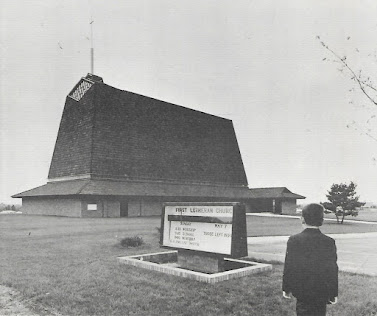First Lutheran of Lincoln - a Bit of History
First Lutheran Church of Lincoln began its life in 1870 as Swedish settlers founded a church in the newly established capital of Nebraska. Though we often assume early founders were heroic pastors, First was mostly a lay movement in its first 30 years, served by a shifting array of preachers who travelled among congregations struggling to establish themselves on the prairie. First Lutheran Swedish Church consisted mostly of new immigrants, many of them young Swedish women brought over as domestics to serve in the houses of the growing town. This early open outreach and service remained a mark of First's ministry, situated as it was in a small structure at 13th and K Street near the heart of the growing town. However, the development of First Lutheran didn't really accelerate until the turn to a new century, when a larger building with a pipe organ was established; the focus on the pipe organ in the expense of building a new structure reveals another long term orientation of the Church, the centrality of music to its identity.
Perhaps the most wrenching transition in First's development over the first half century involved issues of language and identity. In 1920, the Church renamed itself from First Swedish Lutheran Church to simply First Lutheran Church, which reveals a more profound shift to English in the life of the congregation. Though the shift in language was inevitable if the Church wished to thrive, it marked a difficult passage for many in the congregation, as English-language services became the norm, and Swedish got pushed to the periphery, and eventually disappeared altogether by the 1950s.
The real numerical growth in the size of the Church came with a move to 17th and A Street in the early 1930s, following the growth of the city to the south, and with the post-war baby boom of the 1950s, which filled the structure with families and children. This plotting of First's growth with that of Lincoln as a city continued with the expansion of the city eastwards, which led in 1966 to the move to its current location on 70th and A Street in east Lincoln. This transition also marked another expansion of membership and occurred during the corresponding move of the Augustana Synod to join the new Lutheran Church in America. The suburban location brought steady growth in numbers up into the 1990s, a continued focus on social ministry and music, the latter marked by the installation of a pipe organ in the late 1980s, and successive expansions of its facilities.
While the changes that have come with time have presented challenges to the congregation, one of the marks of the Church has been the ability to preserve unity and our commitment to the larger Nebraska Synod and the ELCA and to evolve the life of the congregation to meet the challenges of the changing times. This is represented in many ways: the continuing commitment to double-tithe our resources to benevolences, including strong support of the ELCA; the opening of the Church to immigrants from Africa, most notably a Nuer-language service; the openness to develop a broad welcoming profile for the Church as it reaches out to all of God's children; the drive to make the Church fully accessible as it finished its most recent expansion in 2020; and the development of online and virtual worship and fellowship to protect everyone during the pandemic. As we open up again, we will continue to expand our outreach enhanced by the addition of new physical and virtual accessibility.
While on the surface, almost everything about First Lutheran has changed in the last 150 years in terms of location, structures, language, and denominational membership, beneath the surface it continues to realize those seeds that were planted back in 1870 in its commitment to serve God's larger kingdom and peoples, its desire to learn what God has to teach us about his Word and will, and the faith that through all kinds of changes God is faithful and his love abides in and through his Church.
-written by Patrick Hayden-Roy, a member at First




Comments
Post a Comment